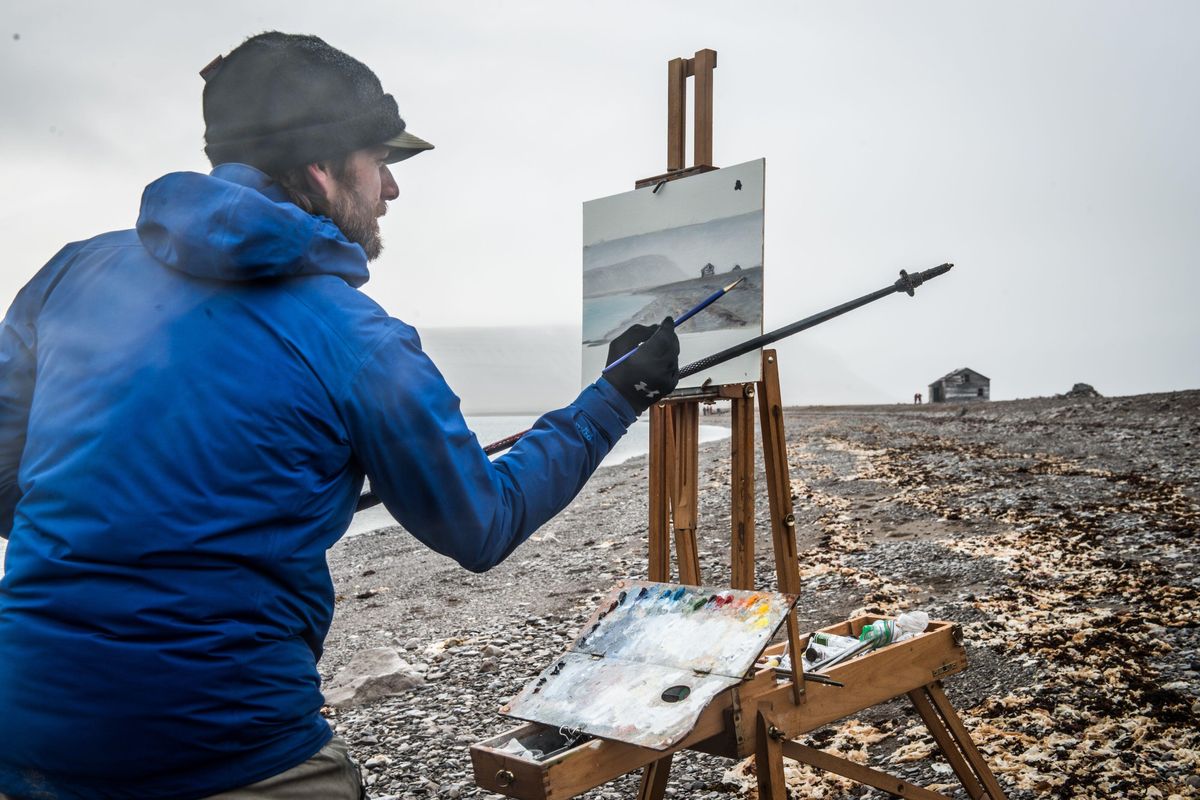Arctic artist: Trépanier travels into Canadian wilderness for his works

An artist can encounter tough obstacles when putting brush to canvas. But plein air painter Cory Trépanier’s challenges rise to another level altogether.
For the past decade Trépanier, 50, lugged a backpack laden with easel, oils and camping gear to capture the beauty of the most remote regions of the Canadian Arctic. The artist, based in southern Ontario, ventured for months at a time into the wilderness, encountering hungry wolves and swarms of biting mosquitoes. He braved treacherous waters and bone-chilling temperatures.
Trépanier went so far as to sleep with a shotgun handy and both ends of his tent unzippered, ready to run in case one of the polar bears he spotted earlier that day settled on him as a late night snack.
The resulting works are as immediate and breathtaking as nature itself. More than 60 oil paintings chronicling Trépanier’s four Arctic expeditions will be included in the exhibition “Into the Arctic”, opening Saturday at the Northwest Museum of Arts and Culture. Highlighting the collection is Trépanier’s 15-foot wide “Great Glacier,” quite possibly the largest Arctic landscape painting in Canada’s history.
Trépanier said he hopes his show will connect people to the awesomeness and fragility of the Arctic.
“I experience firsthand the awe and overwhelming sense of humility that is brought on from the realization of how tiny I am in these expansive landscapes,” Trépanier said. “By connecting to these places, many of which have never been painted or seen, I hope it inspires in people a passion to take care of the land.”
He believes the process of creating the paintings, or starting them “plein air” (outside), serves to enhance the works themselves. He typically finishes the canvases in his studio barn in rural Ontario where he lives in a small farmhouse with his wife.
“By putting yourself into an environment, it heightens your senses on so many levels, so that you are more like a sponge for what’s going on all around you,” Trépanier said. “When you are completely immersed, and you are open to unexpected awe, and the light strikes something in a certain way, it’s like you are enraptured.
“Then there’s the rush to try to capture that on canvas as quickly as possible, and knowing that the moment may pass, or you may start to freeze as you sit on a glacier with the wind howling … It all kind of feeds into the experience,” Trépanier said. “And I guess it’s kind of addictive.”
Trépanier’s life wasn’t always so full of outdoor adventure.
For the first decade of his career after graduating from university, he worked in commercial art, mostly airbrush painting for ad agencies and magazines. He was 33 when he took a trip to Lake Superior to paint the natural landscape. The experience was so transformative that he eventually hung up his air brushes and took out his oils to explore the land. He was named one of Canada’s top 100 Living Explorers by Canadian Geographic magazine in 2015. That same year, as a member of the Explorers Club of Canada, he won its highest award, the Stefansson Medal.
Over the past 10 years, in addition to his paints and easel, Trépanier chronicled his adventures on camera. His first feature film, “Into the Arctic I,” includes family scenes from when Trépanier first brought his wife and two young children to camp in the wilderness. “Into the Arctic II” focuses on two expeditions Trépanier took later, without the kids, exploring a wider area and visiting a dozen remote communities. Both films will be shown in a continuous loop alongside the exhibition at the MAC.
Trépanier’s third, “Into the Arctic: Awakening,” wraps up the entire experience over the past decade. It will be officially released as part of a trilogy later this year. The Spokane premiere of the unfinished film will be on Feb. 23, at the MAC’s auditorium. For more showtimes, go to www.northwestmuseum.org and go to the calendar tab.
Another Arctic-based exhibition opening at the MAC on the same day makes for a perfect pairing.
“The Inuit Art of the Povungnituk,” will showcase sculptors and print makers of the village of Povungnituk, located in Arctic Quebec. These artists are celebrated for the quality of their print making and distinctive style.
For thousands of years, sculptures made of bone, antler, ivory and soapstone were carved by the Inuit people of the village of Povungnituk, serving both utilitarian and ceremonial purposes. In the 1950s, the villagers formed a cooperative to build on the carving tradition. Their work has been described as unselfconscious and honest, reflecting the realities of Arctic life and the mystery of legends and myths.
Unlike other Inuit print makers who used wood, the Povungnituk print makers carved relief drawings into the surface of stones. The rough texture creates a distinctive print. Crisp images of native animals and human figures set against stark backgrounds portray rituals of survival in the harsh northern regions.
The Povungnituk exhibition will include prints by Paulosie Sivuak, one of the collective’s most celebrated artists. Produced during the 1980s, his polar bears, seagulls and walruses capture his appreciation for the playfulness and caprice inherent in the process of natural selection. Works depicting human activity reflect a spontaneous spirit and the essence of Inuit life.
Trépanier said his hope is that his exhibition can help add context to the exhibition of indigenous Arctic artists.
“It’s a wonderful pairing,” Trépanier said. “(Through my exhibition), people can perhaps connect and somewhat experience the land in which those powerful works by the Inuit artists was birthed.”